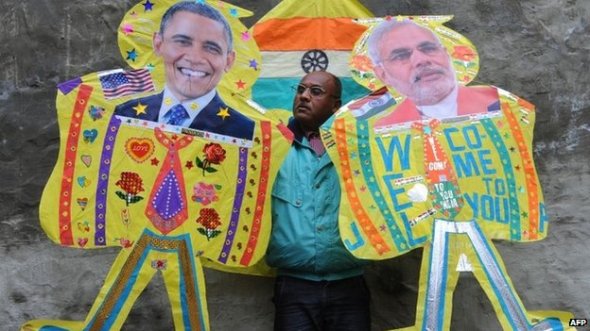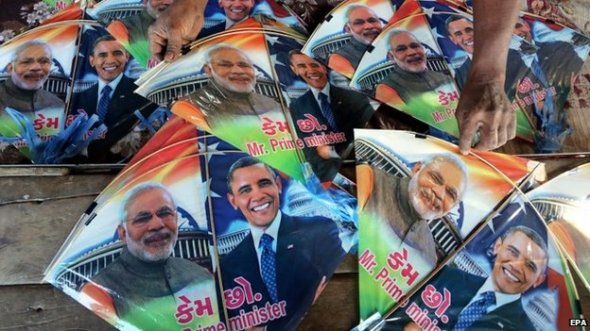redo Jump to...
print Print...

President Barack Obama will be the chief guest at India’s Republic Day celebrations in Delhi
(by Aditya Kalra, Reuters) – India’s capital will turn into a virtual fortress for President Obama’s visit this weekend, with heightened security measures, including an extended no-fly zone, to protect the world’s most powerful leader.
Prime Minister Narendra Modi, Obama and other dignitaries from the world’s two largest democracies will attend India’s Republic Day celebrations on Jan. 26, which include a military parade and display of Indian weaponry. [India’s Republic Day honors the date on which the Constitution of India came into force (January 26, 1950) replacing the Government of India Act (1935) as the governing document of India. It is one of three national holidays in India, other two being Independence Day and Gandhi Jayanti.]

This is the first time that a US head of state is the chief guest at India’s Republic Day celebrations
For past celebrations, Indian security agencies enforced a no-fly zone with a radius of 190 miles, but it will be extended to 250 miles this year, covering cities such as Jaipur in the west, and Agra, home to the famed Taj Mahal, and extending to the border with regional rival Pakistan.
“The no-fly zone has been extended around Delhi … no civil aircraft can take off or land during that time,” said one Indian security official, who asked not to be identified because of the sensitivity of the security details.
While a no-fly zone bars commercial flights during the two-hour procession the program wraps up with a fly-past by military planes.
“There is no concern about security,” said India’s home ministry. But stakes are high, as Obama’s visit comes a month after Pakistan Taliban killed 132 children in a school in Peshawar, forcing India to issue a nationwide alert.
 Clashes across the India-Pakistan border have intensified, along with concerns that militant Islamic commanders in Afghanistan and Pakistan have renewed their focus on India as foreign forces leave the region.
Clashes across the India-Pakistan border have intensified, along with concerns that militant Islamic commanders in Afghanistan and Pakistan have renewed their focus on India as foreign forces leave the region.
Late last year Al Qaeda set up an Indian Subcontinent branch, and other militants are looking to Islamic State [ISIS] for inspiration. India blames Pakistan for attacks such as a 2001 assault on parliament and the commando-style 2008 Mumbai rampage [during which terrorists] killed 166 people. …
On-the-ground security has been beefed up, with extra police patrols and checks at metro stations. Snipers will be deployed at more than 70 high-rise buildings around central Delhi, the security official said.
President Obama will be accompanied by First Lady Michelle Obama on his three-day trip and is expected to travel in ‘The Beast,’ his heavily-armored limousine. They plan to tour the Taj Mahal, about 125 miles south of the capital.
A team of 40 U.S. security experts has already inspected the Taj Mahal, a police official said. Newspapers showed images of U.S. officials patrolling the river behind the monument.
[The Daily Mail reports: The President and Mrs. Obama also traveled to India in 2010 (Malia and Sasha accompanied them on that trip). The President’s visit to India in 2010 was the biggest by any U.S. president – with 40 aircraft and six armored cars. The President’s limo, which has its own built in communications center, enables him to be in touch with the White House, U.S. vice president and the U.S. strategic command. The car also has the U.S. nuke launch codes and the nuclear switch for the president. It can also withstand a chemical or germ warfare or even a bomb attack.](Reporting by Aditya Kalra, Sanjeev Miglani and Sunil Kataria)
Reprinted here for educational purposes only. May not be reproduced on other websites without permission from Thomson Reuters. Visit the website at Reuters .com.
Questions
1. Find the following information about India:
a) capital
b) location/the countries that share its borders
c) the religious breakdown of the population
d) the type of government
e) the chief of state (and head of government if different)
f) the population
2. What is India’s Republic Day?
3. The U.S. and India are the world’s two largest __________________.
4. What is the Indian government doing to ensure President Obama’s safety during the India Republic Day parade? (What measure is mentioned in this news article?)
5. Why is the Indian government taking such measures with their security?
6. What is the U.S. doing to ensure President Obama’s safety during his 3-day trip to India?
CHALLENGE: Read the “Background” below. Follow the news next week about President Obama’s trip. What types of agreements did he make with Prime Minister Modi during their meetings?
Background
CNN on the strategy behind President Barack Obama’s India trip – What Obama’s trip to India reveals about his SOTU agenda
- President Obama says he’s on the offensive, and he has certainly unveiled an ambitious list of proposals in the weeks leading up to the State of the Union speech Tuesday night.
- But Julie Pace of The Associated Press notes that his schedule contradicts his rhetoric as he crosses into one of the indisputable stages of a lame-duck presidency: nonessential foreign travel.
- “He’s going to India basically for a parade and a visit to the Taj Mahal,” said Pace.
- “Think about the timing of this. The President is going to India three days after his State of the Union address. A period of time when he normally would be out trying to rally Congress and the public behind his agenda. I think this says all you need to know about the likelihood that anything he announce[d] on Tuesday actually gets done.” (from cnn)
The Wall Street Journal’s analysis: Obama in India – 4 Reasons to Keep Expectations in Check
President Barack Obama‘s upcoming three-day visit to India aims to build on the momentum of Prime Minister Narendra Modi‘s week-long visit to the U.S. in September – a trip flush with soaring rhetoric and goodwill.
Both capitals are exuding optimism. Washington’s new ambassador to New Delhi proclaimed that President Obama’s visit would herald a “new era in India-U.S. partnership.” Headlines in Indian media suggest that the trip will galvanize the relationship.
Still, don’t expect the hoopla and hype to culminate in major substantive outcomes. Here are four reasons why:
1. It’s too soon. Mr. Obama and Mr. Modi met in Washington only four months ago. It’s difficult for both sides to put together a big-ticket agreement with so little lead time – especially when both leaders, despite pledges to deepen the relationship, have been consumed by many other foreign policy matters in recent months.
2. U.S. domestic politics. Many of India’s chief priorities are linked to protracted political debates in Washington that extend far beyond the bilateral relationship. For example, New Delhi wants Washington to address perceived restrictions on H-1B visas awarded to U.S.-based Indian workers – but this issue is tied to broader immigration reform, which is stymied in Congress. India wants to take advantage of U.S. liquid natural gas exports – but the United States has restrictions on sending such products to nations with which it has no free-trade agreement, and loosening the restrictions would require wider policy reforms.
3. The lingering influence of inconvenient Indian policies. The U.S. wish list is hindered by the resilience of dogmatic Indian policies. Many U.S businesses fervently want to invest in India’s services industry–but this sector, reflecting India’s traditional emphasis on state-centered economic policies, is deeply protectionist and hesitant to open up to foreign investment. Similarly, India’s legacy of nonalignment–a Cold War-era foreign policy strategy that eschewed alliances–means that Washington won’t easily get New Delhi to formally join the U.S.-led coalition against Islamic State.
4. Bilateral tensions. Despite major improvements in relations since the 1990s, U.S.-India ties remain plagued by policy divides on issues as diverse as how to deal with Russia and global climate-change negotiations. Mistrust lingers from the Cold War, and this ill will resurfaced in late 2013, when the arrest and strip-search of an Indian consular official living in New York plunged relations into deep crisis. Such baggage must be unpacked before milestone agreements and achievements can emerge.
None of this is to suggest that Mr. Obama’s visit will not yield deliverables. We can expect modest accords on defense, economics, and energy – but nothing like the civil nuclear deal of 2008, which some described as the cornerstone of an emerging strategic partnership.
Today, that agreement remains largely unimplemented – and stands as a symbol of unmet expectations. So let’s keep our expectations in check for Mr. Obama’s visit. It will feature much happy talk but few substantive outcomes.
From Reuters: Top issues during Obama’s India visit
U.S. President Barack Obama arrives in India on Sunday for the second time, to build on what he calls one of the defining relationships of the 21st Century. Here are some key areas likely to be discussed during his visit:
Strategic importance – India’s size, location, fast-growing economy and potential as a democratic counterbalance to China makes the South Asian nation an increasingly key element of U.S. military and commercial strategy. In return for closer ties, India wants greater cooperation on terrorism and access to high-technology goods for civilian and military use.
Defense – The United States overtook Russia as the biggest weapons supplier to India, the Indian government said in August. India is the world’s biggest importer of weapons and the United States is the biggest arms supplier. Standing in the way of closer ties are Indian restrictions on foreign companies owning majority stakes in defence companies and U.S. curbs on exporting certain technologies.
Civil nuclear – U.S. and Indian officials will discuss ways to unblock billions of dollars of potential trade in nuclear energy.India and the United States signed a landmark civilian nuclear deal in 2008. Holding up the trade is India’s reluctance to pass legislation shielding suppliers from liability in the event of a nuclear accident, a deviation from international norms.
Renewable energy – India wants companies from the United States to help lead investments of $100 billion in renewable energy. Prime Minister Narendra Modi promised to help renewable energy companies overcome entry to the Indian market during his trip to Washington last year. A barrier to investment is a requirement that foreign companies make much of the equipment within India, which business leaders say will push up costs.
Climate Change – The United States and India are expected to announce efforts to work together to combat climate change ahead of key global talks in Paris later this year. India, the world’s third largest carbon emitter, is reluctant to follow the United States and China in committing to a peak year for emissions on the grounds it needs economic growth to alleviate poverty. Instead, India is likely to trumpet its plans for a rapid expansion of renewable energy, for which it needs U.S. investment and technology, and improving energy efficiency.
Economic Ties – Modi and Obama last year targeted a five-fold increase in annual trade to $500 billion. But U.S. business leaders have been frustrated by limits on their access to the Indian market, and battles over intellectual property protection. India and the United States have also filed several cases against each other at the World Trade Organisation over protection of their domestic steel, poultry and solar industries. (Reuters)
Daily “Answers” emails are provided for Daily News Articles, Tuesday’s World Events and Friday’s News Quiz.



